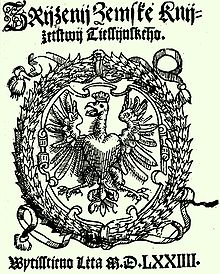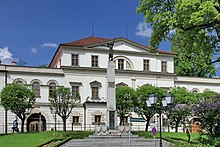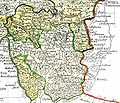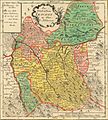Duchy of Teschen
Duchy of Teschen | |||||||||||
|---|---|---|---|---|---|---|---|---|---|---|---|
| 1290–1918 | |||||||||||
Roman Catholicism | |||||||||||
| Dukes | |||||||||||
• 1290–1315 | Mieszko I (first duke) | ||||||||||
• 1625–1653 | Elizabeth Lucretia (last Piast ruler) | ||||||||||
• 1895–1918 | Archduke Frederick Habsburg (last duke) | ||||||||||
| History | |||||||||||
• Partitioned from Opole-Racibórz | 1281 | ||||||||||
• Split off Oświęcim | 1315 | ||||||||||
• Vassalized by Bohemia | 1327 | ||||||||||
• Split off Bielsko | 1572 | ||||||||||
• Habsburg rule | 1653 | ||||||||||
• Part of Austrian Silesia | 1742/45 | ||||||||||
• Disestablished | 1918 | ||||||||||
| 28 July 1920 | |||||||||||
| Population | |||||||||||
• 1910 | 350,000 | ||||||||||
| |||||||||||
1 Coat of arms of the Duchy of Teschen and the regional branch of the Piast dynasty | |||||||||||
The Duchy of Teschen (
The ducal lands initially comprised former Lesser Polish territories east of the Biała River, which in about 1315 again split off as the Polish Duchy of Oświęcim, while the remaining duchy became a fiefdom of the Bohemian kings in 1327 and was incorporated into the Lands of the Bohemian Crown in 1348. While the bulk of Silesia was conquered by the Prussian king Frederick the Great in the Silesian Wars of 1740–1763, Teschen together with the duchies of Troppau (Opava), Krnov and Nysa remained with the Habsburg monarchy and merged into the Austrian Silesia crown land in 1849. The so-called "commander line" of the Habsburg-Lorraine dynasty, a cadet branch descending from Archduke Charles, Duke of Teschen, held the title "Duke of Teschen" until 1918.
History
The duchy shared the history of the

Defying the Polish
Piast rule
Like most of his Silesian Piast relatives, Mieszko approached the mighty
After Mieszko's death in 1315, his son

After the death of Duke
While the Lands of the Bohemian Crown passed to the
The Cieszyn Piast rule continued until 1653, when the male line became extinct with the death of Adam Wenceslaus' son
Habsburg rule

Ferdinand IV ruled Teschen until his death in 1654, whereafter the duchy fell back to Emperor Ferdinand III. His Habsburg successors continued the re-Catholicization policies. In 1722 Emperor
Although most of Silesia had passed to Prussia, Teschen with Bielsko and the duchies of
With Austrian Silesia, the territory of Teschen became part of the Cisleithanian half of the Austro-Hungarian dual monarchy upon the Compromise of 1867. At the end of World War I both the crown land and the ducal title were disestablished with the dissolution of Austria-Hungary. Archduke Frederick, appointed Austrian field marshal in 1914 but soon neutralized by Chief-of-Staff Franz Conrad von Hötzendorf, found his vast possessions expropriated and retired to Magyaróvár in Hungary.
Aftermath
At the end of the war, local Polish and Czechoslovak self-governments were established in the territory of Cieszyn, which on 5 November 1918 signed an interim agreement under which the territory – including the town of Cieszyn itself – was divided along the Olza (Olše, Olsa) River. However, the preliminary convention failed to settle the border conflict between the newly established state of Czechoslovakia and the Second Polish Republic, which claimed further areas of the former Cieszyn duchy with a predominantly Polish-speaking population. The ongoing conflict escalated when Czechoslovak troops crossed the Olza on 23 January 1919, starting the Polish–Czechoslovak War.
Clashes of arms continued until 31 January, but neither of the belligerents benefited: at the 1920
Demographics
-
Languages of sermons in Roman Catholic parishes in the 17th century (red - Polish, yellow - Czech, blue - German, striped - Polish and German
-
1910 Austrian census - percentage of Polish-speaking population
-
1910 Austrian census - percentage of Czech-speaking population
-
1910 Austrian census - percentage of German-speaking population
According to the Austrian census taken in 1910, the duchy had about 350,000 inhabitants: 54.8% Polish-speaking, 27.1% Czech-speaking and 18.1% German-speaking.[7] While the Czech population mainly settled in the western areas around Frýdek, the German population was clustered around Bielsko (German: Bielitz).
Dukes of Teschen

Silesian Piasts
- 1290–1315 Mieszko I
- 1315–1358 Casimir I, son, swore homage to King John of Bohemia in 1327
- 1358–1410 Przemyslaus I Noszak, son
- 1410–1431 Boleslaus I, son
- 1431–1442 Wenceslaus I, became Duke of Siewierz and Bielsko
- 1431–1442 Wladislaus, Duke of Głogów
- 1431–1452 Boleslaus II
- 1431–1477 Przemyslaus II
- 1477–1528 Casimir II
- 1518–1524 Wenceslaus II, son, co-ruler with his father
- 1528–1579 Wenceslaus III Adam, son of Wenceslaus II
- 1579–1617 Adam Wenceslaus, son
- 1617–1625 Frederick William, son, left no male heirs
- 1625–1653 Elizabeth Lucretia, sister.
Following the death of
House of Habsburg-Lorraine
- 1722–1729 Leopold
- 1729–1765 Francis I Stephen, son, husband of Maria Theresa, Holy Roman Emperor from 1745
- 1765–1766 Emperor Joseph II, son
- 1766–1797 Archduchess Maria Christina
- 1766–1822 Prince Albert Casimir, husband
- 1822–1847 Charles, nephew and adoptive son
- 1847–1849 Albert, son
- Titular dukes
- 1849–1895 Albert
- 1895–1918 Frederick, nephew, title abolished in Austrian law in 1918.
- Archduke Albrecht Franz, Duke of Teschen (1897–1955) continued to use the title after the death of his father.
Old maps
-
The Duchy of Teschen: 17th/18th century map by Matthäus Seutter
-
The Duchy of Teschen in 1724, by Jonas Nigrinus
-
The Duchy of Teschen in 1736, by Matthaeus Schubarth
-
The Duchy of Teschen. 1746 map by Johann Homann
-
17th/18th century map of the Duchy of Teschen by Joh David Schleuen
-
Polish map of the Duchy of Cieszyn, 20th century
Footnotes
- ^ Panic 2002, 6.
- ^ "Teschen | region, Europe". Encyclopedia Britannica. Retrieved 2018-10-04.
- ^ Panic 2002, 7.
- ^ Panic 2002, 16.
- ^ Žáček 2004, 175
- ^ Decree of the Conference of Ambassadors with regard to Teschen, Spisz and Orava, dated Paris, August 5, 1920, League of Nations Treaty Series, vol. 2, pp. 50-58
- ^ Nowak 2008, 13.
References
- Biermann, Gottlieb (1894). Geschichte des Herzogthums Teschen (in German) (2nd ed.). OCLC 34926439.
- Nowak, Krzysztof (2008). "Polskość i ruch narodowy". In Krzysztof Nowak (ed.). Pierwsza Niepodległość. Cieszyn: Urząd Miejski Cieszyn. pp. 7–17. ISBN 978-83-89835-40-6.
- OCLC 55650394.
- Žáček, Rudolf (2004). Dějiny Slezska v datech. Praha: Libri. ISBN 80-7277-172-8.
















